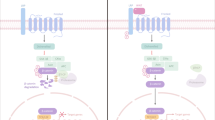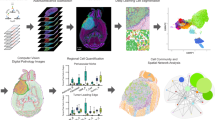Abstract
Milk fat globule—epidermal growth factor—factor VIII (MFGE8), also called lactadherin or SED1, is a secreted integrin-binding protein that promotes elimination of apoptotic cells by phagocytes leading to tolerogenic immune responses, and vascular endothelial growth factor (VEGF)-induced angiogenesis: two important processes for cancer development. Here, by transcriptomic analysis of 228 biopsies of bladder carcinomas, we observed overexpression of MFGE8 during tumor development, correlated with expression of genes involved in cell adhesion or migration and in immune responses, but not in VEGF-mediated angiogenesis. To test whether MFGE8 expression was instrumental in bladder tumor development, or a simple consequence of this development, we used genetic ablation in a mouse model of carcinogen-induced bladder carcinoma. We showed that Mfge8 was also upregulated in mouse carcinoma, and that in its absence, Mfge8-deficient animals developed less advanced tumors. Angiogenesis was similar in carcinogen-treated Mfge8-expressing or -deficient bladders, thus ruling out a major role of the proangiogenic function of Mfge8 for its protumoral role. By contrast, the tumor-promoting role of Mfge8 was not observed anymore in mice devoid of adaptive immune system, and human tumors overexpressing MFGE8 where invaded with macrophages and regulatory T cells, thus suggesting that MFGE8/lactadherin favors development of bladder tumors at least partly by an immune system-dependent mechanism. Our observations suggest future use of MFGE8-inhibiting molecules as therapies of bladder carcinomas, and of a limited number of other human cancers, in which our analysis of public databases also revealed overexpression of MFGE8.
This is a preview of subscription content, access via your institution
Access options
Subscribe to this journal
Receive 50 print issues and online access
$259.00 per year
only $5.18 per issue
Buy this article
- Purchase on Springer Link
- Instant access to full article PDF
Prices may be subject to local taxes which are calculated during checkout






Similar content being viewed by others
Abbreviations
- BBN:
-
N-butyl-N-(4-hydroxybutyl) nitrosamine
- BCG:
-
Bacillus Calmette-Guérin
- ECM:
-
extracellular matrix
- MFGE8:
-
milk fat globule-epidermal growth factor-factor VIII
- pTNM:
-
pathologic tumor node metastasis classification
- SAM:
-
significance analysis of microarrays
- Tregs:
-
regulatory T cells
- MIT:
-
muscle-invasive tumors
- NMIT:
-
non-muscle-invasive tumors
- VEGF:
-
vascular endothelial growth factor
- vWF:
-
von Willebrand Factor
References
Ait-Oufella H, Kinugawa K, Zoll J, Simon T, Boddaert J, Heeneman S et al. (2007). Lactadherin deficiency leads to apoptotic cell accumulation and accelerated atherosclerosis in mice. Circulation 115: 2168–2177.
Andersen MH, Graversen H, Fedosov SN, Petersen TE, Rasmussen JT . (2000). Functional analyses of two cellular binding domains of bovine lactadherin. Biochemistry 39: 6200–6206.
Atabai K, Fernandez R, Huang X, Ueki I, Kline A, Li Y et al. (2005). Mfge8 is critical for mammary gland remodeling during involution. Mol Biol Cell 16: 5528–5537.
Balkwill F, Charles KA, Mantovani A . (2005). Smoldering and polarized inflammation in the initiation and promotion of malignant disease. Cancer Cell 7: 211–217.
Becci PJ, Thompson HJ, Strum JM, Brown CC, Sporn MB, Moon RC . (1981). N-butyl-N-(4-hydroxybutyl)nitrosamine-induced urinary bladder cancer in C57BL/6 X DBA/2 F1 mice as a useful model for study of chemoprevention of cancer with retinoids. Cancer Res 41: 927–932.
Bu HF, Zuo XL, Wang X, Ensslin MA, Koti V, Hsueh W et al. (2007). Milk fat globule-EGF factor 8/lactadherin plays a crucial role in maintenance and repair of murine intestinal epithelium. J Clin Invest 117: 3673–3683.
Ceriani RL, Sasaki M, Sussman H, Wara WM, Blank EW . (1982). Circulating human mammary epithelial antigens in breast cancer. Proc Natl Acad Sci USA 79: 5420–5424.
de Visser KE, Eichten A, Coussens LM . (2006). Paradoxical roles of the immune system during cancer development. Nat Rev Cancer 6: 24–37.
de Visser KE, Korets LV, Coussens LM . (2005). De novo carcinogenesis promoted by chronic inflammation is B lymphocyte dependent. Cancer Cell 7: 411–423.
Diez de Medina SG, Chopin D, El Marjou A, Delouvee A, LaRochelle WJ, Hoznek A et al. (1997). Decreased expression of keratinocyte growth factor receptor in a subset of human transitional cell bladder carcinomas. Oncogene 14: 323–330.
Draghici S, Khatri P, Tarca AL, Amin K, Done A, Voichita C et al. (2007). A systems biology approach for pathway level analysis. Genome Res 17: 1537–1545.
Eble JN, Sauter G, Eipstein JII, Sesterhenn IE . (2004). World Health Organization Classification of Tumors. Pathology and Genetics of Tumors of the Urinary System and Male Genital Organs. International Agency for research on Cancer Press: Lyon, 91pp.
Ensslin MA, Shur BD . (2003). Identification of mouse sperm SED1, a bimotif EGF repeat and discoidin-domain protein involved in sperm-egg binding. Cell 114: 405–417.
Ensslin MA, Shur BD . (2007). The EGF repeat and discoidin domain protein, SED1/MFG-E8, is required for mammary gland branching morphogenesis. Proc Natl Acad Sci USA 104: 2715–2720.
Fens MH, Mastrobattista E, de Graaff AM, Flesch FM, Ultee A, Rasmussen JT et al. (2008). Angiogenic endothelium shows lactadherin-dependent phagocytosis of aged erythrocytes and apoptotic cells. Blood 111: 4542–4550.
Hanayama R, Nagata S . (2005). Impaired involution of mammary glands in the absence of milk fat globule EGF factor 8. Proc Natl Acad Sci USA 102: 16886–16891.
Hanayama R, Tanaka M, Miwa K, Shinohara A, Iwamatsu A, Nagata S . (2002). Identification of a factor that links apoptotic cells to phagocytes. Nature 417: 182–187.
Hanayama R, Tanaka M, Miyasaka K, Aozasa K, Koike M, Uchiyama Y et al. (2004). Autoimmune disease and impaired uptake of apoptotic cells in MFG-E8-deficient mice. Science 304: 1147–1150.
Inoue M, Hager JH, Ferrara N, Gerber HP, Hanahan D . (2002). VEGF-A has a critical, nonredundant role in angiogenic switching and pancreatic beta cell carcinogenesis. Cancer Cell 1: 193–202.
Jinushi M, Nakazaki Y, Carrasco DR, Draganov D, Souders N, Johnson M et al. (2008). Milk fat globule EGF-8 promotes melanoma progression through coordinated Akt and twist signaling in the tumor microenvironment. Cancer Res 68: 8889–8898.
Jinushi M, Nakazaki Y, Dougan M, Carrasco DR, Mihm M, Dranoff G . (2007). MFG-E8-mediated uptake of apoptotic cells by APCs links the pro- and antiinflammatory activities of GM-CSF. J Clin Invest 117: 1902–1913.
Komura H, Miksa M, Wu R, Goyert SM, Wang P . (2009). Milk fat globule epidermal growth factor-factor VIII is down-regulated in sepsis via the lipopolysaccharide-CD14 pathway. J Immunol 182: 581–587.
Larocca D, Peterson JA, Urrea R, Kuniyoshi J, Bistrain AM, Ceriani RL . (1991). A Mr 46 000 human milk fat globule protein that is highly expressed in human breast tumors contains factor VIII-like domains. Cancer Res 51: 4994–4998.
McCormick DL, Ronan SS, Becci PJ, Moon RC . (1981). Influence of total dose and dose schedule on induction of urinary bladder cancer in the mouse by N-butyl-N-(4-hydroxybutyl)nitrosamine. Carcinogenesis 2: 251–254.
Nandrot EF, Anand M, Almeida D, Atabai K, Sheppard D, Finnemann SC . (2007). Essential role for MFG-E8 as ligand for alphavbeta5 integrin in diurnal retinal phagocytosis. Proc Natl Acad Sci USA 104: 12005–12010.
Neutzner M, Lopez T, Feng X, Bergmann-Leitner ES, Leitner WW, Udey MC . (2007). MFG-E8/lactadherin promotes tumor growth in an angiogenesis-dependent transgenic mouse model of multistage carcinogenesis. Cancer Res 67: 6777–6785.
Oshima K, Aoki N, Kato T, Kitajima K, Matsuda T . (2002). Secretion of a peripheral membrane protein, MFG-E8, as a complex with membrane vesicles. Eur J Biochem 269: 1209–1218.
Pollard JW . (2004). Tumour-educated macrophages promote tumour progression and metastasis. Nat Rev Cancer 4: 71–78.
Saint F, Patard JJ, Groux Muscatelli B, Lefrere Belda MA, Gil Diez de Medina S, Abbou CC et al. (2001). Evaluation of cellular tumour rejection mechanisms in the peritumoral bladder wall after bacillus Calmette-Guerin treatment. BJU Int 88: 602–610.
Sharma P, Old LJ, Allison JP . (2007). Immunotherapeutic strategies for high-risk bladder cancer. Semin Oncol 34: 165–172.
Shi J, Heegaard CW, Rasmussen JT, Gilbert GE . (2004). Lactadherin binds selectively to membranes containing phosphatidyl-L-serine and increased curvature. Biochim Biophys Acta 1667: 82–90.
Sica A, Schioppa T, Mantovani A, Allavena P . (2006). Tumour-associated macrophages are a distinct M2 polarised population promoting tumour progression: potential targets of anti-cancer therapy. Eur J Cancer 42: 717–727.
Silvestre JS, Thery C, Hamard G, Boddaert J, Aguilar B, Delcayre A et al. (2005). Lactadherin promotes VEGF-dependent neovascularization. Nat Med 11: 499–506.
Stransky N, Vallot C, Reyal F, Bernard-Pierrot I, de Medina SG, Segraves R et al. (2006). Regional copy number-independent deregulation of transcription in cancer. Nat Genet 38: 1386–1396.
Stubbs JD, Lekutis C, Singer KL, Bui A, Yuzuki D, Srinivasan U et al. (1990). cDNA cloning of a mouse mammary epithelial cell surface protein reveals the existence of epidermal growth factor-like domains linked to factor VIII-like sequences. Proc Natl Acad Sci USA 87: 8417–8421.
Taylor MR, Couto JR, Scallan CD, Ceriani RL, Peterson JA . (1997). Lactadherin (formerly BA46), a membrane-associated glycoprotein expressed in human milk and breast carcinomas, promotes Arg-Gly-Asp (RGD)-dependent cell adhesion. DNA Cell Biol 16: 861–869.
Veron P, Segura E, Sugano G, Amigorena S, Thery C . (2005). Accumulation of MFG-E8/lactadherin on exosomes from immature dendritic cells. Blood Cells Mol Dis 35: 81–88.
Williams PD, Lee JK, Theodorescu D . (2008). Molecular credentialing of rodent bladder carcinogenesis models. Neoplasia 10: 838–846.
Xu L, Shen SS, Hoshida Y, Subramanian A, Ross K, Brunet JP et al. (2008). Gene expression changes in an animal melanoma model correlate with aggressiveness of human melanoma metastases. Mol Cancer Res 6: 760–769.
Acknowledgements
We thank Drs A-C Baglin and Y Denoux (Tumorothèque, Service d'Anatomie et Cytologie Pathologiques, CMC Foch, Suresnes, France), Dr M-J Terrier-Lacombe (Service de Pathologie, Institut Gustave Roussy, Villejuif, France), and Professor K Leroy (Plateforme de Ressources Biologiques, Pôle de Recherche Clinique, APHP, Hôpital Henri Mondor, Créteil, France) for providing tumor samples. Microbiochips SAS (Paris, France) performed and analyzed antibody microarray hybridizations. This work would not have been possible without the expertise of the Animal Facility and of the Nikon Imaging Center at Institut Curie. We thank S Barrafato and F Valenty (mouse histology), K Zemplenyi (ultrasound analyses), E Chapeaublanc (preparation of Supplementary tables), B Asselain and A Savignoni (statistics) for their help, and V Soumelis, H Kitamura and JW Pollard for critical reading of the manuscript. This work was supported by grants from Association pour la Recherche Contre le Cancer and Fondation de France ‘Impulsion’ program (CT), La Ligue Nationale Contre le Cancer (FR: équipe labellisée), and the program ‘Carte d'Identité des Tumeurs’, initiated, developed and funded by Ligue Nationale Contre le Cancer. GS was a fellow from Ministére de la Recherche et des Technologies.
Author information
Authors and Affiliations
Corresponding author
Ethics declarations
Competing interests
The authors declare no conflict interest.
Additional information
Supplementary Information accompanies the paper on the Oncogene website
Supplementary information
Rights and permissions
About this article
Cite this article
Sugano, G., Bernard-Pierrot, I., Laé, M. et al. Milk fat globule—epidermal growth factor—factor VIII (MFGE8)/lactadherin promotes bladder tumor development. Oncogene 30, 642–653 (2011). https://doi.org/10.1038/onc.2010.446
Received:
Revised:
Accepted:
Published:
Issue Date:
DOI: https://doi.org/10.1038/onc.2010.446
Keywords
This article is cited by
-
Inframe insertion and splice site variants in MFGE8 associate with protection against coronary atherosclerosis
Communications Biology (2022)
-
A bi-directional dialog between vascular cells and monocytes/macrophages regulates tumor progression
Cancer and Metastasis Reviews (2021)
-
Regulation of efferocytosis as a novel cancer therapy
Cell Communication and Signaling (2020)
-
Exosomes released upon mitochondrial ASncmtRNA knockdown reduce tumorigenic properties of malignant breast cancer cells
Scientific Reports (2020)
-
Identification and functional characterization of lactadherin, an agglutinating glycoprotein from the chordate Styela clava
In Vitro Cellular & Developmental Biology - Animal (2019)



